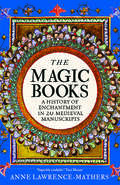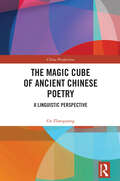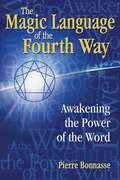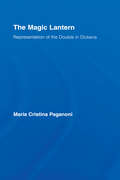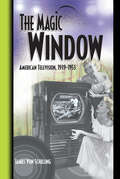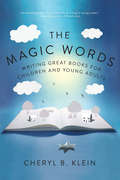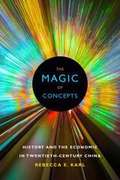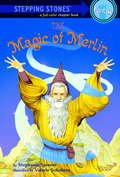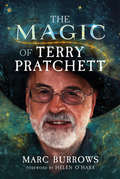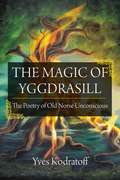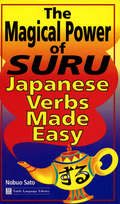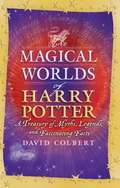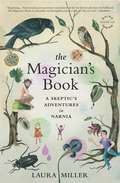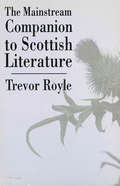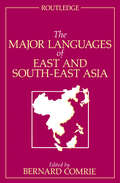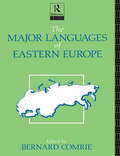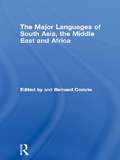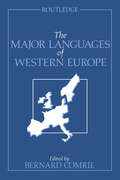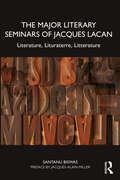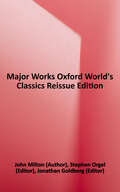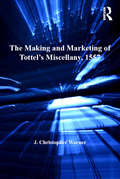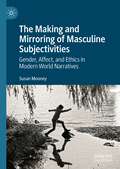- Table View
- List View
The Magic Books: A History of Enchantment in 20 Medieval Manuscripts
by Anne Lawrence-MathersA fascinating and highly original history of medieval magic told through twenty key illuminated manuscripts Medieval Europe was preoccupied with magic. From the Carolingian Empire to Renaissance Italy and Tudor England, great rulers, religious figures, and scholars sought to harness supernatural power. They tried to summon spirits, predict the future, and even prolong life. Alongside science and religion, magic lay at the very heart of culture. In this beautifully illustrated account, Anne Lawrence-Mathers explores the medieval fascination with magic through twenty extraordinary illuminated manuscripts. These books were highly sought after, commissioned by kings and stored in great libraries. They include an astronomical compendium made for Charlemagne&’s son; The Sworn Book of Honorius, used by a secret society of trained magicians; and the highly influential Picatrix. This vivid new history shows how attitudes to magic and science changed over the medieval period—and produced great works of art as they did so.
The Magic Cube of Ancient Chinese Poetry: A Linguistic Perspective (China Perspectives)
by Ge ZhaoguangThis book focuses on the linguistic perspective of classical Chinese poetry and its changes and development in diff erent historical periods. It off ers a combination of theoretical analysis and aesthetic appreciation of exemplary poems. The author discusses the following aspects of classical Chinese poetry: the relationships between background and meaning in the interpretation of a poem; how readers can deal with the tangle of linguistic approach and intuitive perception in interpreting poems; the engagement and disengagement of the poet’s thought fl ow with and from the word order of the verse; the tonal and metrical schemes; and the three special features of classical Chinese poetry: the signifi cance and role of allusions, “Xu Zi”, and “Shi Yan”. Last, the author analyses the development of Chinese poetry from the Vernacular Song Dynasty Style to the Vernacular Modern Style. It will be a great read for students and scholars of East Asian studies, Chinese studies, linguistics, and those interested in Chinese poetry in general. The book aims to lead readers to discover a fresh and amazing world of classical Chinese poetry, a fantastic panoramic picture of its beauty and charm, and a poetic feast that the reader may not otherwise be privileged to enjoy.
The Magic Language of the Fourth Way: Awakening the Power of the Word
by Pierre BonnasseAn application of Gurdjieffian principles to fully and properly activate the power of language • Explains the relationship between the Gurdjieff enneagram and sacred geometry and harmonics • Shows that the objective power of language--and art and music--lies in the ability to use symbols that will mean precisely the same thing to anyone • Includes a new English translation of René Daumal’s essay “The Holy War” In The Magic Language of the Fourth Way, Pierre Bonnasse applies the esoteric teachings of Fourth Way mystic G. I. Gurdjieff and the insights of initiate René Daumal to show how to fully and properly activate the power of language. Bonnasse shows how words can regain the strange magical powers they possessed in the first days of humanity, when words created the realities of what they described. This is a far cry from today’s world in which even writers lament the impotent nature of language.Bonnasse uses the relationship between the Gurdjieff enneagram and sacred geometry and harmonics to reveal the power given to words by the notes of the scale. He shows not only how to discover the objective power of words but also how to apply the relationship between language and living to maximum effect. He explains that the objective power of language--and art and music--lies in the ability to use symbols that will mean precisely the same thing to anyone. The Magic Language of the Fourth Way serves as a clear and generous introduction to the complexities of Gurdjieffian thought as well as a descriptive how-to manual for Fourth Way aspirants on the uses of objective language for spiritual advancement.
The Magic Lantern: Representations of the Double in Dickens (Studies in Major Literary Authors)
by Maria Cristina PaganoniThe book provides an original investigation of the double trope as a central area of Dicken’s writings in their relation to Victorian culture, using this examination of the double to shed light on such issues as urban space and imperialism in the Victorian era.
The Magic Window: American Television ,1939-1953
by Jim Von SchillingFirst published in 2002. Routledge is an imprint of Taylor & Francis, an informa company.
The Magic Words: Writing Great Books for Children and Young Adults
by Cheryl KleinThis master class in writing children's and young adult novels will teach you everything you need to know to write and publish a great book. The best children's and young adult novels take readers on wonderful outward adventures and stirring inward journeys. In The Magic Words, editor Cheryl B. Klein guides writers on an enjoyable and practical-minded voyage of their own, from developing a saleable premise for a novel to finding a dream agent. She delves deep into the major elements of fiction--intention, character, plot, and voice--while addressing important topics like diversity, world-building, and the differences between middle-grade and YA novels. In addition, the book's exercises, questions, and straightforward rules of thumb help writers apply these insights to their own creative works. With its generous tone and useful tools for story analysis and revision, The Magic Words is an essential handbook for writers of children's and young adult fiction.
The Magic of Concepts: History and the Economic in Twentieth-Century China
by Rebecca E. KarlIn The Magic of Concepts Rebecca E. Karl interrogates "the economic" as concept and practice as it was construed historically in China in the 1930s and again in the 1980s and 1990s. Separated by the Chinese Revolution and Mao's socialist experiments, each era witnessed urgent discussions about how to think about economic concepts derived from capitalism in modern China. Both eras were highly cosmopolitan and each faced its own global crisis in economic and historical philosophy: in the 1930s, capitalism's failures suggested that socialism offered a plausible solution, while the abandonment of socialism five decades later provoked a rethinking of the relationship between history and the economic as social practice. Interweaving a critical historiography of modern China with the work of the Marxist-trained economist Wang Yanan, Karl shows how "magical concepts" based on dehistoricized Eurocentric and capitalist conceptions of historical activity that purport to exist outside lived experiences have erased much of the critical import of China's twentieth-century history. In this volume, Karl retrieves the economic to argue for a more nuanced and critical account of twentieth-century Chinese and global historical practice.
The Magic of Merlin
by Stephanie SpinnerIn the days of knights and castles, one man knew all the secrets of magic. His name was Merlin. Merlin saw the future. He cast powerful spells. He brought King Arthur to the throne and helped him rule England. Together Merlin and Arthur made history—and became legend. Kids who love magic won’t want to miss this story of Merlin, the greatest magician ever, and his friendship with the once and future king, Arthur, with its beautiful full-color illustrations of Camelot, magic objects, and knights in shining armor. Stephanie Spinner is the author of the popular early chapter book trilogyAliens for Breakfast, Aliens for Lunch,andAliens for Dinner, as well the well-reviewed novel for children,Quiver. The author lives in New York, NY. Russian-born Valerie Sokolova is finding a new home in the American publishing industry with her elaborate illustrations, such as the ones in theGolden Treasury of Christmas Joy. She lives in Brooklyn, NY. From the Trade Paperback edition.
The Magic of Terry Pratchett
by Marc BurrowsAn in-depth look into the life and writings of the bestselling author of the Discworld novels, Good Omens, and Nation.The Magic of Terry Pratchett is the first full biography of Sir Terry Pratchett ever written. Sir Terry was Britain’s bestselling living author*, and before his death in 2015 had sold more than 85 million copies of his books worldwide. Best known for the Discworld series, his work has been translated into thirty-seven languages, and performed as plays on every continent in the world, including Antarctica.Journalist, comedian and Pratchett fan Marc Burrows delves into the back story of one of UK’s most enduring and beloved authors, from his childhood in the Chiltern Hills, to his time as a journalist, and the journey that would take him—via more than sixty best-selling books—to an OBE, a knighthood and national treasure status.The Magic Of Terry Pratchett is the result of painstaking archival research alongside interviews with friends and contemporaries who knew the real man under the famous black hat, helping to piece together the full story of one of British literature’s most remarkable and beloved figures for the very first time.* Now disqualified on both counts.Praise for The Magic of Terry Pratchett"In this encompassing biography of the prolific fantasy and science-fiction author, writer and comedian Burrows details both the writing accomplishments and the personal life of Sir Terry Pratchett. . . . Burrows spoke to friends and family, and this biography has moments of sadness, especially when discussing Pratchett’s fight with Alzheimer’s. But the book is also funny and conversational in tone, and an excellent tribute to a beloved author.” —Booklist“Affable and consistently engaging . . . Burrow’s buoyant, pun-peppered, and aptly footnote-flecked style . . . helpfully marries his subject matter, propelling us through decade after decade of a heavily writing-centric life while illuminating Pratchett’s complexities and contradictions without any drag in the tempo.” —Locus Magazine“An impressively comprehensive, engagingly written biography. ****”—SFX
The Magic of Yggdrasill: The Poetry of Old Norse Unconscious
by Yves 45800 KodratoffThis book took its start with the author’s realization that what Old Norse calls 'magic' can be understood as 'unconscious', as stated by C. G. Jung: (we find) 'magical means everything where unconscious influences are at work.' This book reveals the exi
The Magical Power of Suru
by Nobuo SatoThe Magical Power of Suru contains twelve chapters of lively, helpful dialogues, dealing with common activities like shopping, traveling, getting a job, doing business, and visiting a Japanese home. This handy book is the perfect language tool for beginning, intermediate, or advanced students who need to converse in a wide variety of situations quickly and effortlessly.
The Magical Worlds of Harry Potter: A Treasury of Myths, Legends, and Fascinating Facts
by David ColbertHave Witches always flown on broomsticks? Where does magic come from? How did J. K. Rowling pick those weird names? Rowling fills Harry Potter's world with real history and famous legends from around the world. This book tells all about them. Discover the astonishing origins behind your favorite characters, scenes, beasts, and everything else too. From Alchemists to Unicorns; Basilisks to Veela, it's all here in this handy guide. Includes notations on Stone through Goblet as well as the HP textbooks.
The Magician's Book: A Skeptic's Adventures in Narnia
by Laura MillerTHE MAGICIAN'S BOOK is the story of one reader's long, tumultuous relationship with C.S. Lewis' The Chronicles of Narnia. Enchanted by its fantastic world as a child, prominent critic Laura Miller returns to the series as an adult to uncover the source of these small books' mysterious power by looking at their creator, Clive Staples Lewis. What she discovers is not the familiar, idealized image of the author, but a more interesting and ambiguous truth: Lewis's tragic and troubled childhood, his unconventional love life, and his intense but ultimately doomed friendship with J.R.R. Tolkien. Finally reclaiming Narnia "for the rest of us," Miller casts the Chronicles as a profoundly literary creation, and the portal to a life-long adventure in books, art, and the imagination.
The Maids (SparkNotes Literature Guide Series)
by SparkNotesThe Maids (SparkNotes Literature Guide) by Jean Genet Making the reading experience fun! Created by Harvard students for students everywhere, SparkNotes is a new breed of study guide: smarter, better, faster. Geared to what today's students need to know, SparkNotes provides: *Chapter-by-chapter analysis *Explanations of key themes, motifs, and symbols *A review quiz and essay topicsLively and accessible, these guides are perfect for late-night studying and writing papers
The Mainstream Companion to Scottish Literature
by Trevor RoyleThe Mainstream Companion to Scottish Literature is the most comprehensive reference guide to Scotland's literature, covering a period from the earliest times to the early 1990s. It includes over 600 essays on the lives and works of the principal poets, novelists, dramatists critics and men and women of letters who have written in English, Scots or Gaelic. Thus, as well as such major writers as Robert Henryson, William Dunbar, Gavin Douglas, Allan Ramsay, Robert Fergusson, Robert Burns, Walter Scott, Robert Louis Stevenson and Hugh MacDiarmid, the Companion also lists many minor writers whose work might otherwise have been overlooked in any survey of Scottish literature.Also included here are entries on the lives of other more peripheral writers such as historians, philosophers, diarists and divines whose work has made a contribution to Scottish letters.Other essays range over such general subjects as the principal work of major writers, literary movements, historical events, the world of printing and publishing, folklore, journalism, drama and Gaelic. A feature of the book is the inclusion of the bibliography of each writer and reference to the major critical works. This comprehensive guide is an essential tool for the serious student of Scottish literature as well as being an ideal guide and companion for the general reader.
The Majic Bus: An Academic Odyssey
by Douglas BrinkleyProfessor Brinkley arranged to teach a six-week experimental class aboard a sleeper bus. The class would visit 30 states and ten national parks. They would read 12 books by American writers. Driven by Brinkley's energetic prose, "The Majic Bus" is a spirited travelogue of their unique experience.
The Major Languages of East and South-East Asia
by Bernard ComrieBased on Bernard Comrie's much praised The World's Major Languages, this is a key guide to an important language family. The areas covered include Chinese, Japanese and Sino-Tibetan languages.
The Major Languages of Eastern Europe (The\major Languages Ser.)
by Bernard ComrieFirst published in 2003. Routledge is an imprint of Taylor & Francis, an informa company.
The Major Languages of South Asia, the Middle East and Africa (The\major Languages Ser.)
by Bernard ComrieBased on the much-praised The World's Major Languages, this is the first comprehensive guide in paperback to describe the development, grammar sound and writing system, and sociological factors of the major language families in these areas.
The Major Languages of Western Europe
by Bernard ComrieBased on Bernard Comrie's The World's Major Languages, this is a key guide to one of the major language families. The areas covered include Germanic languages, English, and Romance languages.
The Major Literary Seminars of Jacques Lacan: Literature, Lituraterre, Litterature
by Santanu BiswasThe Major Literary Seminars of Jacques Lacan considers the three key phases of Lacan’s interest in literary topics.Santanu Biswas first examines the seminars given between 1955 and 1961, in which Lacan spoke on Edgar Allan Poe’s short story "The Purloined Letter", Hamlet, Sophocles’ Antigone, and Paul Claudel’s The Coûfontaine Trilogy, and where literature is related to meaning. This is followed by an exploration of Lacan’s seminar on "Lituraterre" in 1971, wherein Lacan elaborates on the different ways in which literature appeared to turn towards lituraterre. Finally, Biswas considers Lacan’s 1975–1976 seminar on James Joyce, who created literature out of “litter” and was concerned with jouissance rather than with meaning.The Major Literary Seminars of Jacques Lacan will be of great interest to Lacanian psychoanalysts, other mental health practitioners interested in the teachings of Lacan, and academics and students of Lacanian studies, literature, and psychoanalysis.
The Major Victorian Poets: Reconsiderations (Routledge Revivals)
by Isobel ArmstrongFirst published in 1969, this edition collection brings together a series of essays offering a re-evaluation of Victorian poetry in the light of early 20th Century criticism. The essays in this collection concentrate upon the poets whose reputations suffered from the great redirection of energy in English criticism initiated in this century by Eliot, Richards and Leavis. What theses poets wrote about, the values they expressed, the form of the poems, the language they used, all these were examined and found wanting in some radical way. One of the results of this criticism was the renewal of interest in metaphysical and eighteenth-century poetry and corresponding ebb of enthusiasm for Romantic poetry and for Victorian poetry in particular. Most of the essays in this book take as their starting point questions raised by the debate on Victorian poetry, both earlier in this century and in the more recent past. There are essays on the poetry of Tennyson, Browning and Arnold, on that of Clough, who until recently has been neglected, and Hopkins, because of, rather than in spite of, the fact that he is usually considered to be a modern poet. The volume is especially valuable in that it will give a clearer understanding of the nature of Victorian poetry, concentrating as it does on those areas of a poet’s work where critical discussion seems most necessary.
The Major Works (Oxford World's Classics) Reissue Edition
by John MiltonPreviously published in the Oxford Authors series, this unique one-volume selection of Milton's poetry and prose includes all the English and Italian verse and a generous selection of his major prose works. Modernized spelling, extensive notes, and a helpful introduction make the text immediately accessible to the modern reader. About the Series: For over 100 years, Oxford World's Classics has made available the broadest spectrum of literature from around the globe. Each affordable volume reflects Oxford's commitment to scholarship, providing the most accurate text plus a wealth of other valuable features, including expert introductions by leading authorities, voluminous notes to clarify the text, up-to-date bibliographies for further study, and much more.
The Making and Marketing of Tottel’s Miscellany, 1557: Songs and Sonnets in the Summer of the Martyrs’ Fires (Catholic Christendom, 1300-1700)
by J. Christopher WarnerFirst published in the summer of 1557 - as the protestant martyrs’ pyres blazed across England - Songes and Sonettes, written by the ryght honorable Lorde Henry Haward late Earle of Surrey, and other (more generally known as Tottel’s Miscellany) is widely regarded as the first anthology of English poetry responsible for introducing Italianate verse forms to England. Yet those scholars who have paid attention to the book usually dismiss its literary quality and regard its chief accomplishment as paving the way for the Golden Age of Elizabethan verse to come. As Professor Warner makes clear, however, there is much more historical significance to the Miscellany than merely being a precursor to Shakespeare and Sidney. Drawing upon a wealth of historical, textual and literary evidence, this new study recasts the Miscellany as a peculiar phenomenon of the reign of Mary I. Placing it in the context of its European counterparts and its competition in the London book market, Warner argues that at heart the Miscellany was a collaborative project between the printer, Richard Tottel and law students from the Inns of Court, and represented a timely response to the religious, political and social upheavals of the English Reformation and Counter-Reformation. Analysing from both a literary and historical perspective, this study reconnects the Miscellany with the social, cultural, literary and religious milieu in which it was created. Warner thus reveals not only the distinctiveness of the book’s design compared to other English verse works for sale in 1557, but its function as a patriotic retort to Continental collections of verse -including one that put into print a selection of satirical songs and sonnets written by the Spanish caballeros who found themselves reluctant attendants at the court of Mary I.
The Making and Mirroring of Masculine Subjectivities: Gender, Affect, and Ethics in Modern World Narratives
by Susan MooneyThis book shows how diverse, critical modern world narratives in prose fiction and film emphasize masculine subjectivities through affects and ethics. Highlighting diverse affects and mental states in subjective voices and modes, modern narratives reveal men as feeling, intersubjective beings, and not as detached masters of master narratives. Modern novels and films suggest that masculine subjectivities originate paradoxically from a combination of copying and negation, surplus and lack, sameness and alterity: among fathers and sons, siblings and others. In this comparative study of more than 30 diverse world narratives, Mooney deftly uses psychoanalytic thought, narrative theories of first- and third-person narrators, and Levinasian and feminist ethics of care, creativity, honor, and proximity. We gain a nuanced picture of diverse postpaternal postgentlemen emerging out of older character structures of the knight and gentleman.
